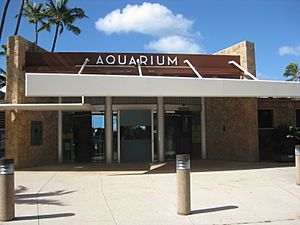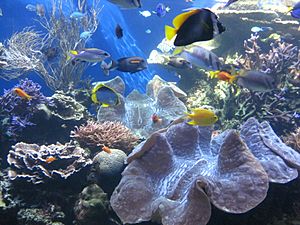Waikīkī Aquarium facts for kids

The entrance to the Waikīkī Aquarium
|
|
| Date opened | March 19, 1904 |
|---|---|
| Location | Honolulu, Hawaii, United States |
| Coordinates | 21°15′57″N 157°49′19″W / 21.2659°N 157.8220°W |
The Waikīkī Aquarium is a popular aquarium in Honolulu, Hawaii. It first opened way back in 1904, making it the second-oldest public aquarium still running in the United States! Since 1919, it has been part of the University of Hawaiʻi at Mānoa.
The aquarium is built right on the shoreline next to a living coral reef. It's home to more than 3,500 sea creatures, with 490 different species of marine plants and animals. Every year, more than 330,000 people visit to see the amazing underwater world. The aquarium also helps teach over 30,000 students each year about ocean life.
Contents
How the Aquarium Began
The Waikīkī Aquarium was started on March 19, 1904, by the Honolulu Rapid Transit Authority. This was a trolley company, and they built the aquarium to give people a fun reason to ride the trolley to the end of the line at Queen Kapiʻolani Park. At first, it was called the Honolulu Aquarium.
In 1955, the aquarium moved to where it is today, just a short distance from its original spot. This is when it was renamed the Waikīkī Aquarium. When it first opened, it had 35 tanks and about 400 sea animals. A famous biologist at the time said it had the best collection of fish in the world.
Directors and Their Legacies
The aquarium has had five directors who helped it grow and become a center for learning and science. Many of them even had sea creatures named in their honor!
- Frederick A. Potter (1904–1940): He was the first director. Even without a science degree, he was passionate about Hawaiian fish. The Potter's Angelfish (Centropyge potteri) is named after him.
- Spencer Tinker (1940–1973): The second director, Tinker wrote popular books about Hawaiian sea life. The beautiful Tinker's Butterflyfish (Chaetodon tinkeri) is named in his honor.
- Dr. Leighton Taylor (1975–1986): As the third director, Dr. Taylor brought big changes. He started the Education Department, the gift shop, and got the aquarium accredited by the Association of Zoos and Aquariums (AZA). This means it met high standards for animal care. A fish called Taylor's goby (Trimma taylori) is named for him.
- Dr. Bruce Carlson (1990–2004): The fourth director, Dr. Carlson helped design new exhibits that looked more like natural ocean habitats. He also started a program to grow corals right at the aquarium. Four different reef animals are named after him, including two fish and two colorful sea slugs called nudibranchs.
- Dr. Andrew Rossiter (2004–Present): The fifth director, Dr. Rossiter, wants to teach the public about protecting the ocean and its coral reefs. He works to modernize the aquarium and continue its mission of research and education.
Groundbreaking Exhibits and Discoveries
The Waikīkī Aquarium has been a leader in caring for and displaying marine life. It has achieved many "firsts" in the aquarium world.
- Living Corals: In 1978, it was the first aquarium in the United States to create exhibits with living Pacific corals. Some of the corals you can see there today are over 30 years old!
- Chambered Nautilus: It was the first aquarium in the U.S. to successfully keep the chambered nautilus, a mysterious deep-sea creature with a spiral shell. It was also the first in the world to produce healthy nautilus babies.
- Other Firsts: The aquarium was also the first to display blacktip reef sharks, broadclub cuttlefish, and mahimahi.
One of its most famous residents is a giant clam (Tridacna gigas). It arrived in 1982 and is now the longest-lived giant clam in any aquarium in the world.
Because of its amazing work, the aquarium has won many national awards for its exhibits and its success in caring for and breeding sea animals.
Art at the Aquarium
Visitors to the aquarium can also see unique works of art inspired by the ocean. These include a set of colorful ceramic sculptures called "Tropical Sounds" and a large ceramic tile mural from 1975 called Vita Marinae, which means "Life of the Sea."
See also
 In Spanish: Acuario de Waikiki para niños
In Spanish: Acuario de Waikiki para niños
- Kapiolani Park
- Kuhio Beach Park


